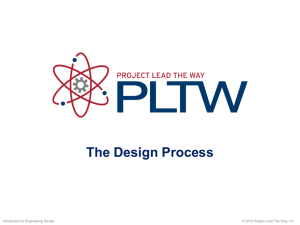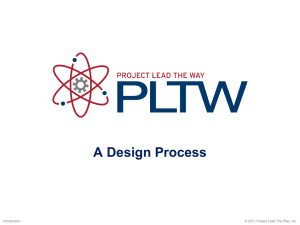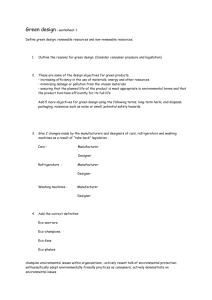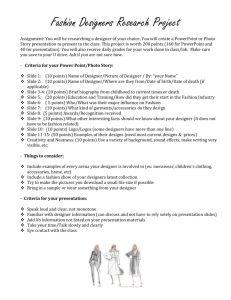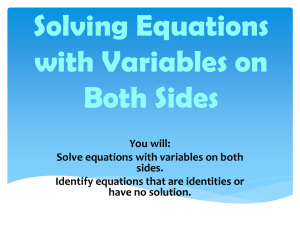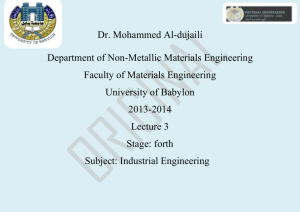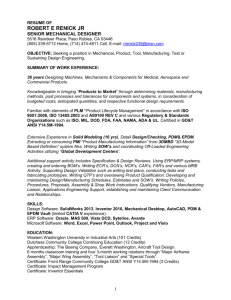The value added and need for prefessional industrial design
advertisement
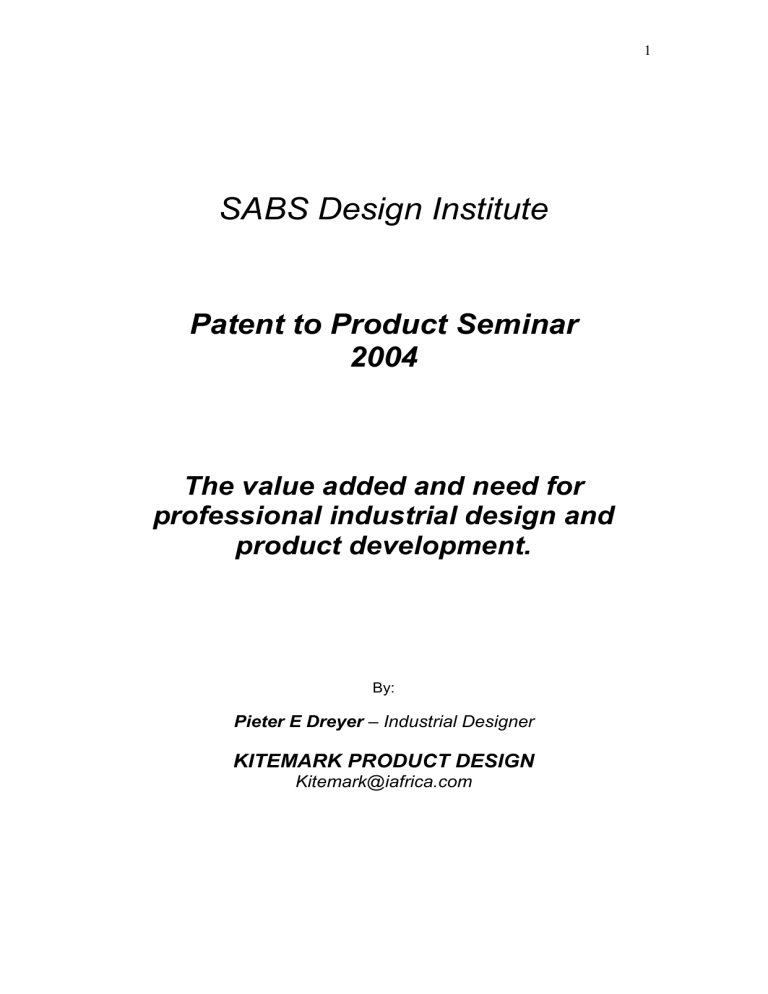
1 SABS Design Institute Patent to Product Seminar 2004 The value added and need for professional industrial design and product development. By: Pieter E Dreyer – Industrial Designer KITEMARK PRODUCT DESIGN Kitemark@iafrica.com 2 Contents: A) Background: Who is a Designer? What is Industrial Design? Value adding defined B) Why Design – What value added? User value Risk Management “Know-how” and experience Cost Advantage and Competitive Edge through design Time to Market C) How to Design – Manage the value adding Problem Identification Identify resources Design process D) Conclusion – Maximise value adding “Cut-Off Point” When is the design process complete? E) Gallery Examples of modern Industrial Design: F) Questions? 3 A) Background 1) Who is a Designer? Everybody has an idea sooner or later; even the most non-technical person can have several ideas during their lifetime. Creativity is a basic human quality and was far more prevalent in our past. Humans were forced to invent and create items that would help them perform their daily tasks. Today our consumer society suppresses these creative abilities by claiming that one can buy anything you will ever need and furthermore that, if you don’t own a certain item, your life cannot possibly proceed without untold misery and a severe lack of social standing. Everybody with the ability to reason is therefore a designer. This basic skill is as old as the human race. “Cavemen” were in fact very good designers! They had a clear understanding of the task that needed to be performed. Their designs were not cluttered with social hang-ups or commercial constraints. These Cavemen fully understood their materials as well as the required manufacturing processes as the designer also became the manufacturer. Products were mainly functional with occasional decorative features. Added value was not a requirement while new inventions were part of discovering the basic laws of physics. The fact that some ideas are better than others is true, but some of the best ideas will never see the light because most individuals don’t know how to pursue their commercial potential. Most new ideas are inspired by the problem the invention claims to solve. Most new functional products strive to improve on the existing solutions and normally require less effort by the user. 2) What is Industrial Design? Industrial Design was first defined during the Industrial Revolution. Product Design is as old as the human race itself, while Industrial Design is the art of developing products for mass production. Industrial Design concerns itself with not only the pure function of the product, but also all the other constraints inflicted on the design in order to make it a commercially successful product. Industrial Design closes the gap between the scientist \ inventor who conceives the device and the salesman who must sell it at a price the market will bear. The Industrial Designer traditionally has been labelled as a stylist with a basic insight into mechanics. The modern Industrial Designer has become far more specialised and offers a professional service with a very 4 wide scope. Industrial Design has been referred to as the link between art and engineering. Definition of modern Industrial Design: Industrial Design is a controlled process of compromise that gives birth to products that are acceptable to the mass market. Typical activities and considerations during the modern Industrial Design process must be: Market trends and styles User requirements State of the art manufacturing processes and materials Commercial constraints Innovation Value adding Marketability and product image Project Management Good Industrial Design cannot be applied as an afterthought like a coat of paint for cosmetic purposes. It has to be an integral part of the development. 3) Value adding defined Value adding is the conscious activity that runs parallel with the activities associated with the design process. It is therefore not a separate activity, but rather a manner in which design related activities are performed. The term “Value Adding” suggests that it is value that the customer \ end-user acquires without paying for the bonus value. This perceived value often becomes the competitive edge that a product requires in today’s overcrowded marketplace. Again, value adding is something that must be consciously incorporated into the design process from the very start. Some “value adding” that occurs during professional Industrial Design will be discussed in the next section. B) Why Design? The main focus of the modern product development programme must be value adding to the end product, with maximum commercial gain for the owner of that product and its intellectual property. Value adding can benefit both the manufacturer as well as the end-user of the product. The following 5 points highlight some of the advantages that good Industrial Design can add to the development process. Value adding through professional design: 1) User Value: These are the value-added features that are evident to the end-user of the product. These features are often the deciding factor on which products are bought and are formidable weapons in the hands of the marketer of the product. High perceived value Good value for money Functional value Easy user interface Quality and safety Low environmental impact Commercial value and cost saving Low maintenance and running costs 2) Risk Management Modern product development is an expensive exercise and requires a huge financial investment, even for the simplest product. This investment, like any other investment, is not risk free. Sound professional design will add tremendous value as well as improve the risk factor by greatly increasing the chance of commercial success. The Design process must not be viewed as a grouch expense, but rather as a sound investment into the product. Industrial Design lowers the risk by providing: Effective marketing tools Market acceptance and type approval Low liability and safety risks Effective development management Sound mechanical functionality 3) “Know-how” and experience The professional Designer has many years of experience and can identify the classic pitfalls prior to the design process. It is also very important to associate your product’s development with companies and suppliers that are prepared to add value to the design process. The professional Designer also 6 has a vast knowledge base of state of the art production methods and materials. Widen solution scope Add to intellectual property State of the art results Gain knowledge Contacts and proven track record 4) Cost advantage & Competitive edge Professional design fees are not cheap. The initial investment is soon recuperated when the added value results in commercial successes and increased profit. Cheaper production Higher selling price – perceived value Innovative features Long term upgrade programme Competitive edge through know-how and intellectual property 5) Time to market In today’s fast changing marketplace the competitive edge is normally reserved for the company that first introduces a specific product. The design process must be managed in such a manner as to ensure effective design without compromising on the end result. The following aspects can achieve this “quick” design cycle: Avoid repetition work by following a proven design process Quick and easy manufacturing \ assembly Resource management and subcontracting Effective product simulation with professional prototypes and computer models Well defined tooling programme Suitable manufacturers …………………… 7 C) How to design – Manage the value adding In today’s global competitive marketplace, products are expected to be state of the art while being cost-effective. This means that the same philosophy must be applied to the design process. Nobody can be a jack of all trades and master the various disciplines. The inventor \ client might not be a good designer, but must understand the basics of the design process in order to manage the value adding. However, there are certain tasks that are also the responsibility of the inventor: 1) Problem Identification: Most products or inventions are designed to perform a particular task. To truly understand the problem or task, must be the first activity in the design process. This will not only assist in the composition of a design brief, but will also become valuable information when marketing your product. A Design Brief is a document that specifies what the requirements for a new product are. These requirements can be very specific to the task, but should also include information like market identification, commercial aspects and any other special requirement. Most designers, unfortunately, already have a pre-conceived idea of what their invention or product should look like before they compose a proper Design Brief. The danger of this is that one is tempted to write the Brief around your design and not around the problem and market requirements. It might help to get a completely objective person that is not directly involved with the design, to assist you in compiling the Brief. A specific manufacturer or company could have very strict Brief requirements relating to their manufacturing limitations or existing components and products. 2) Identify resources Technology has become extremely specialised and requires experts in the specific field to ensure a competitive product. Most of the biggest international corporate companies have realised this and make extensive use of subcontractors and external design experts to ensure quality product development. 8 Not only must design experts be identified, but also suppliers that are suitable for the specific task at hand. Many inventors could benefit from aligning themselves with marketers and manufactures that are already in the field of the new product which will vastly improve the chances of commercial success. This might mean that the inventor has to settle for a smaller cut of the action, but the bulk of the risk can be shifted to this external company. 3) The Product Design process Professional Product Designers work to a very strict design process to ensure effective product development. This process might vary and should be adopted to suit the specific requirements of the project at hand. Understanding the process will assist you, the client, in effectively managing the process as well as defining milestone expectations. Good design cannot be applied as an afterthought like a coat of paint for cosmetic purposes. It has to be an integral part of the development. Ten Steps of Product Development 1. Product Definition 2. Concept 3. Initial Development 4. Bench Models 5. Final Development 6. Detailed drawings 7. Prototype 8. Documentation 9. Pre-production 10. Product Introduction No matter how well a proof of principle experiment functions, it is at least ten steps away from being a commercial product. These ten steps are called product development and they close the gap between the inventor who conceives the device and the salesman who must sell it at a price the market will bear. 9 1) Product Definition Marketing analysis Preliminary product description Investigate patent position Preliminary manufacturing costs Preliminary development costs Generate conceptual drawings of models Define hardware and software needs Programme cost justification Define technology requirements Evaluate competitive hardware 2) Concept Illustrations, Industrial Design and renderings Preliminary layouts Initial Selection of OEM (Original Equipment Manufacturer) and “off-theshelf” components Conceptual models Establish design approach 3) Initial Development Mechanical design layout Theoretical design verification Human factor analysis SABS requirements Define Bench-model requirements Define milestones and generate budget Illustrations, Industrial Design and renderings The essence of good design is simplicity. 4) Bench-Models Design bench-model Detail and specify components Build bench-model Define testing required Test bench-model 10 Summarise results and update specifications Sound design principles normally work well even in the crudest of bench-models. 5) Final Development Generate final product specifications. Define budget milestones, labour loading, etc. Complete final layouts. Final OEM component selection. Estimate standard costs and manufacturing requirements. We have to start with the natural form of the machine and its working parts. Most of the time the appearance of the product is the realisation of its natural form. In reality, a functional design will normally improve appearance, reduce manufacturing costs and make the product easier to maintain. 6) Detailed Drawings Updated drawings Schematics Assembly drawings Specifications and procedures Colour schemes and graphics Document OEM requirements Generate artworks Design and documentation check 7) Prototype Release documentation Design short-run tooling Provide manufacturing with engineering liaison Update design layout and documentation Engineering debugging of prototype Test prototype Product development involves much more than shape and appearance. The development team must anticipate the problems that the production engineer will find as he manufactures the machine. How difficult is it for him to make a specially machined part and how much will it add to the cost? Can the design be adapted to use an off-the-shelf component? 11 Will the original material cause problems because it is in short supply or hard to work with? 8) Documentation Final review of prototype and specifications Incorporate design changes Update software and hardware Final documentation check Prepare assembly drawings Formalise assembly procedures Formal test procedures Meet SABS documentation requirements 9) Pre-production Assemble systems Debug assemblies Test QC (Quality Control) components, assemblies and systems The good designer must also know when to stop. The product must offer more benefits than the competition in a form that the consumer finds comfortable and familiar. The critical point of the design, therefore, occurs when we provide the most advanced technology in its simplest form. We freeze the design at this point to ensure that we don't overengineer the product. Design freeze, however, is not the final step. 10) Product Introduction Conduct long-term testing Initiate component test programmes Submissions to SABS, etc. Incorporate changes as required The above ten steps are based on information obtained from the following Internet web site: www.smptech.com (This site is worth a visit) SMP Technology 175 East Campbell Avenue California 12 D) Conclusion – Maximise the value added 1) “Cut-Off Point” Quick decision making is vital in today’s competitive marketplace, and must be made from the start of a project. The “cut-off point” refers to the acceptable status of a task during the design process. Product developers always believe that they can improve their designs and that it is never “quite there”. This process can continue indefinitely and eventually delay the project to the point of rendering it no longer commercially viable. Once a solution is found that works it is best to move onto the next stage of the development process. A wise man once said that making the wrong decision is better than not making the decision at all. The critical point of the design, therefore, occurs when we provide the most advanced technology in its simplest form. 2) When is the design process complete? When does one stop to develop the product? - “The day a company stops designing its products, is the day that those products start to die. Even after a product is released into the marketplace the design process must continue with an eye on improvements and new models. The competitive edge is something that must be pursued continuously with formal structures in place to accommodate the following: Market feedback Competitors New technology Market trends Economical environment Supplier care Companies must not only focus on keeping up with technology and their competitors, but should actively strive to create the new “state- of- the-art” through continuous design. Copyright – 2001 – Pieter E Dreyer All documentation is protected under Copyright laws and cannot be reproduced or copied in any way. The SABS Design Institute has permission to duplicate this documentation for use at the “Patent to Product” seminar-2002/3/4

